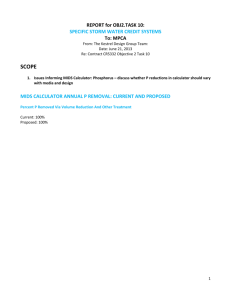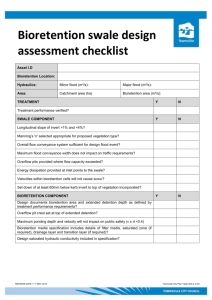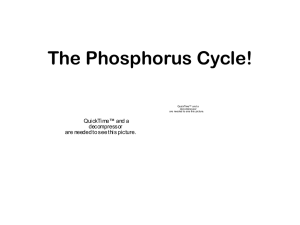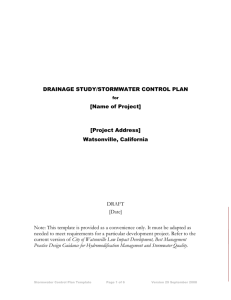Bioretention_task_7_soil_amendments
advertisement
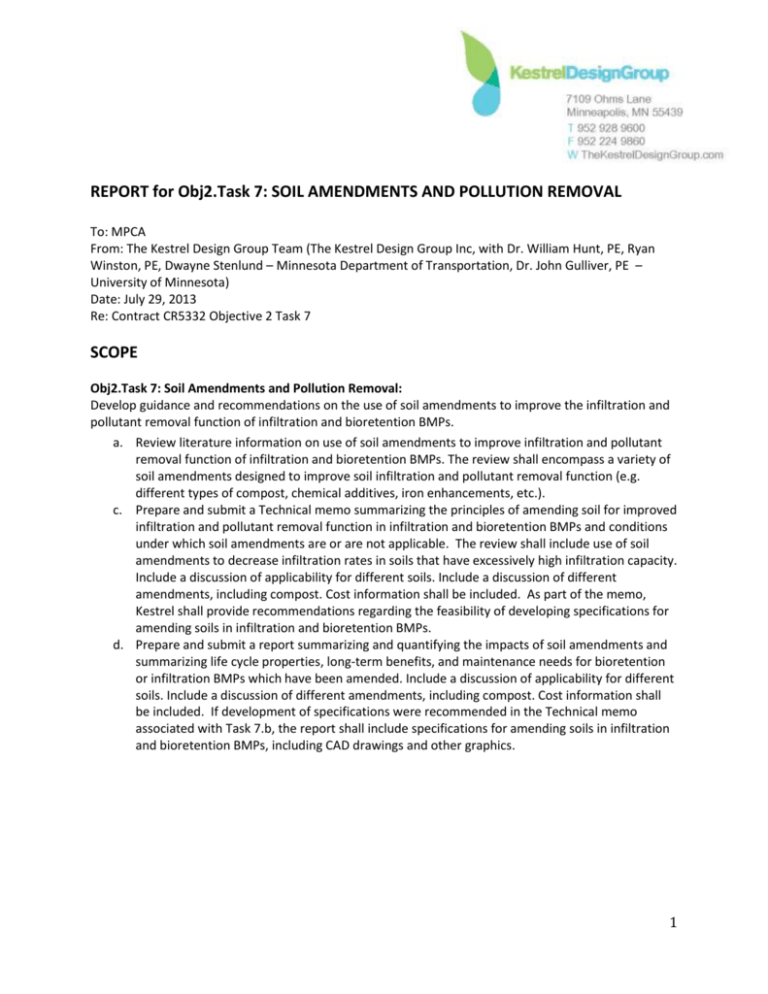
REPORT for Obj2.Task 7: SOIL AMENDMENTS AND POLLUTION REMOVAL To: MPCA From: The Kestrel Design Group Team (The Kestrel Design Group Inc, with Dr. William Hunt, PE, Ryan Winston, PE, Dwayne Stenlund – Minnesota Department of Transportation, Dr. John Gulliver, PE – University of Minnesota) Date: July 29, 2013 Re: Contract CR5332 Objective 2 Task 7 SCOPE Obj2.Task 7: Soil Amendments and Pollution Removal: Develop guidance and recommendations on the use of soil amendments to improve the infiltration and pollutant removal function of infiltration and bioretention BMPs. a. Review literature information on use of soil amendments to improve infiltration and pollutant removal function of infiltration and bioretention BMPs. The review shall encompass a variety of soil amendments designed to improve soil infiltration and pollutant removal function (e.g. different types of compost, chemical additives, iron enhancements, etc.). c. Prepare and submit a Technical memo summarizing the principles of amending soil for improved infiltration and pollutant removal function in infiltration and bioretention BMPs and conditions under which soil amendments are or are not applicable. The review shall include use of soil amendments to decrease infiltration rates in soils that have excessively high infiltration capacity. Include a discussion of applicability for different soils. Include a discussion of different amendments, including compost. Cost information shall be included. As part of the memo, Kestrel shall provide recommendations regarding the feasibility of developing specifications for amending soils in infiltration and bioretention BMPs. d. Prepare and submit a report summarizing and quantifying the impacts of soil amendments and summarizing life cycle properties, long-term benefits, and maintenance needs for bioretention or infiltration BMPs which have been amended. Include a discussion of applicability for different soils. Include a discussion of different amendments, including compost. Cost information shall be included. If development of specifications were recommended in the Technical memo associated with Task 7.b, the report shall include specifications for amending soils in infiltration and bioretention BMPs, including CAD drawings and other graphics. 1 TABLE OF CONTENTS I. A. B. C. D. E. F. G. II. COMPOST Description Stormwater benefits Where it is or is not applicable Life Cycle Properties Long-Term Benefits Maintenance Needs Cost info SOIL AMENDMENTS TO ENHANCE P SORPTION A. Description B. Stormwater benefits 1. Limestone or Calcareous Sand 2. Aluminum-Based Water Treatment Residuals (WTR) a) Lucas and Greenway Aluminum-Based WTR studies b) O’Neill and Davis 2012 (a and b) Aluminum-Based WTR studies c) Agricultural Aluminum-Based WTR Studies 3. Iron Based Water Treatment Residuals (WTR) 4. Iron filings Imbrium Sorptive®MEDIA Examples of Other Innovative Applications of P Sorptive Amendments a) Using by-products like gypsum, mining residuals, or drinking water treatment residuals in filters. b) Using drain pipes enveloped in Fe-coated sand c) Rototilling WTRs into Existing Bioretention Facilities d) Other Emerging Technologies for Reducing P in Surface Water Where it is or is not applicable Life Cycle Properties Long-Term Benefits Maintenance Needs Cost info 5. 6. C. D. E. F. G. 2 III. A. B. C. D. E. F. G. IV. A. B. C. D. E. F. G. V. BIOCHAR Description Stormwater benefits Where it is or is not applicable Life Cycle Properties Long-Term Benefits Maintenance Needs Cost info NETLON ADVANCED TURF SYSTEM Description Stormwater benefits Where it is or is not applicable Life Cycle Properties Long-Term Benefits Maintenance Needs Cost info REFERENCES LIST OF FIGURES Figure 7.1: Percent removal of total dissolved phosphorus for each bioretention cell at each of four different target phosphorus concentrations Figure 7.2: Percent removal of total phosphorus for each bioretention cell at each of four different target phosphorus concentrations Figure 7.3: Netlon Advanced Turf System Figure 7.4: Close-up Image of Netlon Advanced Turf System 3 REPORT SUMMARIZING EXPERIENCE AND THE LITERATURE FINDINGS Much past and current research addresses the potential of soil amendments to improve infiltration and pollutant removal function of infiltration and bioretention BMPs. These soil amendments range from various types of compost, to chemical additives, to manufactured amendments with pollutant sorption capabilities. Examples are listed below. I. COMPOST See Chapter 12.3 of the Minnesota Stormwater Manual, Runoff Volume Minimization, for more information about using compost as a soil amendment. H. Description “Compost is the product resulting from the controlled biological decomposition of organic materials that has been sanitized through the generation of heat and stabilized to the point that it is beneficial to plant growth. It is an organic matter resource that has the unique ability to improve the chemical, physical, and biological characteristics of soil” (Minnesota Stormwater Manual, 2005). It can be derived, for example, from composted yard waste, food waste, manure, leaves, grass clippings, straw, or biosolids. Minnesota’s stormwater manual currently calls for organic leaf compost, MnDOT Type 2 compost, to be used in bioretention media. I. Stormwater benefits 1) Improves the soil’s water and nutrient holding capacity, improving plant health and vigor 2) Results in better soil aggregation into soil peds, which results in better soil tilth and permeability 3) Degrades or immobilizes some stormwater pollutants, such as hydrocarbons, solvents, and heavy metals (Alexander 1999, Hong et al 2006) 4) Reduces need for fertilizer J. Where it is or is not applicable Avoid compost high in phosphorus in projects aiming to minimize phosphorus in runoff from bioretention, as compost can leach phosphorus. Biosolids and manure composts can be higher in bioavailable phosphorus than compost derived from yard or plant waste. Peat (Glader, 2013) and coir (Lucas 2012) compost are lowest in phosphorus and do not typically leach phosphorus. 4 K. Life Cycle Properties While mature compost slowly decomposes, it also encourages vigorous plant growth. Vigorous vegetation will typically replenish organic matter so compost does not need to be replenished. Vegetation adds organic matter to the soil both underground, as roots slough off organic matter, and aboveground, as leaves fall and decompose. In bioretention cells that are 10+ years old, observations of topsoil up to 6” thick have been made due to decomposition of plant detritus L. Long-Term Benefits See stormwater benefits (I.B). M. Maintenance Needs Using compost does not increase maintenance needs. N. Cost info Low cost. II. SOIL AMENDMENTS TO ENHANCE P SORPTION A. Description Principal mechanisms for phosphorus (P) removal in bioretention are the filtration of particulate-bound P and chemical sorption of dissolved P (e.g. summarized in Hunt et al 2012). Most stormwater control measures (SCMs) capture particulate P by settling or filtration, but leave dissolved P (typically phosphates), which is most bio-available, untreated. This untreated P accounts on average for 45% of total phosphorus in stormwater runoff and can be up to 95% of the total phosphorus, depending, for example, on the storm event (Erickson et al 2012). Phosphorus sorbing materials contain a metal cation (typically di or trivalent) that reacts with dissolved phosphorus to create an insoluble compound by adsorption or precipitation or both (Buda et al 2012). Soil components and amendments that have been shown to be effective to increase chemical sorption of dissolved P include: Iron filings (Erickson et al 2012) Steel wool (Erickson et al 2007) 5 Native iron rich soils such as those in the Piedmont of the Mid and Southern Atlantic USA (Hunt et al 2012), or Krasnozem soil in Australia (Lucas and Greenway 2011) Water treatment residuals (WTRs), which are a by-product of drinking water treatment and a source of aluminum and iron hydroxides (O’Neill and Davis 2012 a and b, Hinman and Wulkan 2012, Lucas and Greenway 2011, Lucas and Greenway 2010) Sorptive media (Imbrium) (Balch et al 2013) Buda et al (2012) provide a literature review of P-sorption amendments. Characteristics of ideal P-sorption amendments include low cost, high availability, low toxicity to soil and water resources, potential for reuse as a soil amendment once fully saturated (Buda et al 2012), and no toxicity to plants, wildlife, or children. It is also crucial that soil amendments do not negatively impact soil infiltration rate and ability to grow vigorous plants. Some P sorptive amendments, such as water treatment residuals (WTRs), are waste products turned into a resource to reduce P in bioretention (or agricultural) soils. Results from much of the research to date on use of P-sorbing materials to reduce nutrients in stormwater effluent are promising so far, but much remains to be learned about lifespan and long term effects of P sorbing materials on soils and plants. B. Stormwater benefits P sorptive amendments have been shown to provide effective P retention for the expected lifetime of bioretention facilities (e.g. Lucas and Greenway 2011, O’Neill and Davis, 2012 a and b). Even with sorptive amendments, the presence of healthy vegetation plays a crucial role in extending P reduction lifespan (Lucas and Greenway 2011).”Vegetation is essential not only for uptake, but even more for its effects on extending sorption capacity” (Lucas and Greenway 2011). 1. Limestone or Calcareous Sand Combinations of C 33 sand with limestone or calcareous sand were tested in laboratory columns by Erickson et al (2007). Limestone or calcareous sand is not recommended as a P sorptive amendment in bioretention facilities because it clogged the columns, resulting in hydraulic failure.. 6 2. Aluminum-Based Water Treatment Residuals (WTR) a. Lucas and Greenway Aluminum-Based WTR studies In planted bioretention mesocosms with media consisting of sand, 12% coir peat, and 9-20% WTRs, Lucas and Greenway (2011) found bioretention soil media with aluminum based WTR to be very effective for P reduction. After the equivalent of 32 years of stormwater loading, the media with 20% WTR retained 99% of the stormwater phosphate load. b. O’Neill and Davis 2012 (a and b) Aluminum-Based WTR studies Aiming for a 20 year lifespan, O’Neill and Davis 2012 (a and b) recommend a bioretention soil media of 5% WTR, 3% triple-shredded hardwood bark mulch, and 92% loamy sand for P reduction on the basis of batch, minicolumn, and large column studies. In a comparison of bioretention soil medias (BSM’s) with varying fines concentrations, they found that increasing the concentration of sand (i.e. decreasing fines) improved P reduction. They also found that hardwood bark mulch, a source of organic matter typically low in P, further improved P reduction (O’Neill and Davis 2012a).The authors contend that an oxalateextractable aluminum-, iron-, and phosphorus based metric, the oxalate ratio, can be used to predict P sorption capacity, and suggest that an media oxalate ratio of 20-40 is expected to meet P adsorption requirements for nutrient sensitive watersheds. This media adsorbed 88.5% of the applied P mass, compared to a non-WTR amended control media for which effluent P mass increased 71.2%. “This media consistently produced total phosphorus effluent mean event concentrations < 25 micrograms per liter and exhibited a maximum effluent concentration of only 70 micrograms per liter” (O’Neill and Davis 2012 b). “Concentrations of P as low as 25 micrograms P per liter may be necessary to reduce eutrophication risk depending on receiving water conditions (U.S. Environmental Protection Agency (US EPA 1986) in O’Neill and Davis 2012a). c. Agricultural Aluminum-Based WTR Studies O’Neill and Davis 2012 a and b summarize many agricultural studies that found WTRs to be effective for P reduction at concentrations similar to those recommended by O’Neill and Davis 2012 a and b. 3. Iron Based Water Treatment Residuals (WTR) As reviewed in O’Neill and Davis (2012 a), one study of iron based WTRs found iron based WTRs to be ineffective to P reduction because they solubilized and released all adsorbed P in reducing conditions (Stumm and Morgan 1996 in O’Neill and Davis 2012 a), but another more recent study found this may not be the case (Shober and Sims 2009 in O’Neill and Davis 2012 a). According to Dr. Allen Davis, iron based water treatment residuals “should work just as well, maybe better than Al. The concern with Fe is that if the media becomes anaerobic due to flooding or any other reason, the Fe can be reduced and will 7 dissolve. It adds another layer of complexity to the system.” This concern can be addressed by designing the bioretention practice to ensure the layer where P sorbtion will occur stays aerobic. 4. Iron Filings Research by Erickson et al suggests that the lifespan for iron enhanced sand filtration (5% iron) with a typical impervious area ratio should be at least 30 years (Erickson et al 2012), and dissolved phosphorus capture should be >80% for 30+ years (Erickson 2010). Many agricultural studies have also found several forms of iron enhancements to be effective to capture P (e.g. Chardon et al 2012, Stoner et al 2012, literature review in Buda et al 2012). Research showing that native iron-rich soils also have high P sorption capacity further supports giving dissolved P removal credit (e.g. Lucas and Greenway 2011). Stenlund (2013) has observed that adding iron to soil causes the soil to harden to a rock like medium, and recommends augering holes for plant growth into soils that have been amended with iron. 5. Imbrium Sorptive®MEDIA Imbrium Sorptive®MEDIA, a proprietary P sorbing amendment available from Contech, is an engineered granular media containing aluminum oxide and iron oxide that demonstrates substantial capacity for adsorption of dissolved phosphorus from stormwater runoff. A recent study reported results from monitoring P reduction of 5 bioretention mesocosms with varying concentrations of Imbrium Sorptive®MEDIA (Balch et al 2013). The study is summarized below. Five individual bioretention cells were monitored, each with 50 cm (20 inches) depth of soil that consisted of sand and 15% peat moss. “Four of them had different concentrations of Sorbtive® Media (3%, 5%, 10% and 17% by volume). The fifth cell contained only the sand/peat soil mix and no amendment, and therefore represented a control that provided the ability to determine how much phosphorus was retained by the sand/peat mix alone.” “The total volume of spiked artificial stormwater applied to each cell approximated the volume of cumulative runoff generated in this region [Canada] over a two-year period by a drainage area five times the size of a bioretention cell.” 8 “At every phosphorus concentration, all the cells amended with Sorbtive® Media demonstrated much higher percent removal of phosphorus compared to the control cell with no Sorbtive® Media. The performance gap between the amended cells and the control cell widened as the phosphorus concentration increased. At the 0.2% target phosphorus concentration, mean dissolved phosphorus removal ranged 79-92% for the amended cells compared to 54% for the control cell. At the 0.8% target phosphorus concentration, mean dissolved phosphorus removal ranged 86-98% for the amended cells compared to 20% for the control cell. In the final week of the study, with 0.8% target phosphorus concentration in the artificial stormwater, percent removal of dissolved phosphorus was 82% for the 3% amendment, 97-98% for the 5%, 10%, and 17% amendments, and 11% for the control. These results demonstrate that the Sorbtive® Media maintained high phosphorus adsorptive capacity throughout the study, especially at the 5% and greater amendment levels.” Figure 7.1: Percent removal of total dissolved phosphorus for each bioretention cell at each of four different target phosphorus concentrations (Balch et al 2013) 9 Figure 7.2: Percent removal of total phosphorus for each bioretention cell at each of four different target phosphorus concentrations (Balch et al 2013) Researchers estimate that the lifespan for Imbrium should be at least 10-30 years, depending, for example, on P loading and performance goals (Garbon 2013, Contech Engineering 2013). Contech Engineering (2013) estimated 45% dissolved P removal at 20 years after initial installation of 5% Sorptive media by volume. Field studies with Imbrium are also underway in Wisconsin (Bannerman 2013, personal communication). Additionally, Imbrium media has been used in an upflow filter on a North Carolina wet pond, resulting in >80% removal of dissolved P during ten monitored storm events (Winston 2013, personal communication). To our knowledge, no field installations with Imbrium Sorptive®MEDIA have been monitored long term. 10 Field studies to monitor long term performance of bioretention with P sorbing amendments are recommended, to monitor clogging potential and P reduction performance over the bioretention lifespan. 6. Examples of Other Innovative Applications of P Sorptive Amendments Using P-sorptive amendments to reduce effluent P content from BMP’s is a newly emerging field and the Kestrel team recommends looking for new research publications and updating recommendations as new research results become available, as well as funding research with P-sorptive amendments. Some applications of P-sorptive amendments that are promising but for which there is not sufficient research to recommend them as standard practice yet to our knowledge to date include, for example: a) Using by-products like gypsum, mining residuals, or drinking water treatment residuals in filters. Several researchers have developed ditch filters with P-sorbing materials to intercept surface and subsurface flow ditch water to trap dissolved P. The filters can be replaced as needed when the Psorption sites are full (Schneider 2013, Stoner et al 2012). They report that “Overall, by-products that are elevated in oxalate Al or Fe, WS Ca [water soluble calcium], and BI [buffer index] serve as the best P sorbents in P removal structures, and screening for these properties allows comparison between materials for this potential use. The flow-through approach described in this paper for predicting design curves at specific RT [retention time] and inflow P combinations aids in predicting how much P can be removed and how long a specific material will last until P saturation if the P loading rate for a specific site is known.” (Stoner et al 2012, information in brackets added) We recommend researching the use of such filters on effluent from bioretention systems, as this would likely be an effective technique for P reduction in bioretention systems on projects where use of filters and ability to replace them as needed is realistic and desirable. For research on by-products, testing of composition and leaching of potentially harmful chemicals (e.g. dissolved metals) should be undertaken to ensure public health. b) Using drain pipes enveloped in Fe-coated sand Groenenberg et al. (2013) “tested the performance of a pipe drain enveloped with Fe-coated sand, a side product of the drinking water industry with a high ability to bind Pfrom the [agricultural] drainage water.”They report that “The results of this trial, encompassing more than one hydrological season, are very encouraging because the efficiency of this mitigation measure to remove P amounted to 94%. During the trial, the pipe drains were below the groundwater level for a prolonged time. Nevertheless, no reduction of Fe(III) in the Fe-coated sand occurred, which was most likely prevented by reduction of Mn oxides present in this material. The enveloped pipe drain was estimated to be able to lower the P concentration in the effluent to the desired water quality criterion for about 14 yr. Manganese oxides 11 are expected to be depleted after 5 to 10 yr. The performance of the enveloped pipe drain, both in terms of its ability to remove P to a sufficiently low level and the stability of the Fe-coated sand under submerged conditions in the long term, needs prolonged experimental research.” Application of this technique could also potentially be effective for reducing P in effluent from bioretention systems with underdrains. Unlike the filter application described in Schneider 2013, though, the iron around the pipe cannot easily be removed and replaced when the P binding sites are full. However, depending on P, Ca, and iron concentrations, there may be enough P sorption sites to last the lifespan of the bioretention system. This application is similar to bioretention systems currently being tested by Bannerman in Wisconsin (Bannerman, 2013) c) Rototilling WTRs into Existing Bioretention Facilities O’Neill and Davis 2012b also suggest that established bioretention facilities could be retrofitted for increased P reduction by rototilling WTRs into the media, as agricultural surface application has been shown to be effective. Bioretention facilities may need to be re-planted after roto-tilling WTRs into the media, however, as rototilling would likely damage roots of existing vegetation. Alternatively perhaps a different way could be found to incorporate WTRs into existing bioretention facilities, such as, perhaps by airspading out some of the existing soil around existing vegetation, and replacing the soil that was removed with bioretention soil media amended with WTR’s. This technique could perhaps be used to renew P sorption capacity of bioretention facilities when P sorption sites are filled. d) Other Emerging Technologies for Reducing P in Surface Water See the Special Section: Emerging Technologies To Remove Nonpoint P Sources From Surface Water And Groundwater in Volume 41 Issue 3, May 2012 of the Journal of Environmental Quality for more articles on this topic. C. Where it is or is not applicable Removal of dissolved phosphorus requires a comparatively high hydraulic retention time, and therefore a deeper media (Hsieh et al. 2007 in Hunt et al 2012). Media depth should therefore be at least 0.6 m, with 0.9 m recommended (Hunt et al 2012). Infiltration rates between 0.007–0.028 mm∕s (1–4 in∕h) work best, as this increases the hydraulic retention time, allowing for more sorption to occur (Hunt et al 2012). If the media is saturated where phosphorus is stored, P is likely to leach out. So if an IWS layer is used, it should be located below the P-sequestering portion of the media. Therefore, a 0.45–0.6 m (1.5–2 ft) separation is recommended between the top of the IWS layer and the media surface (Hunt et al 2012). The P-sorptive amendment should be located at least 0.5 ft above the top of the IWS zone (Winston, 2013). 12 D. Life Cycle Properties See B. Stormwater Benefits E. Long-Term Benefits See B. Stormwater Benefits F. Maintenance Needs Soil amendments to enhance P sorption typically do not increase bioretention maintenance needs. Water treatment residuals (WTR’s) are fine textured, so systems with WTR’s should be designed to minimize clogging. Hinman and Wulkan (2012) recommend adding shredded bark at 15% by volume for each 10% WTRs added by volume to compensate for the fine texture of WTRs. Iron filings can be obtained with a size distribution similar to sand. Erickson et al (2012) found that hydraulic conductivity of a sand filter was not negatively affected when operated for a year with up to 10.7% iron filings, which is enough iron to capture a significant percent of dissolved P. G. Cost info Soil amendments to enhance P sorption are a relatively low cost technique to improve long term dissolved P removal. Steel wool, for example, has been found to increase the material cost by 3–5% (Erickson et al 2007). Iron filings cost less than steel wool per unit weight because they require less manufacturing to produce (Erickson et al 2012). Since WTRs are byproducts of the water treatment process, they can often be procured for little or no cost. III. BIOCHAR A. Description Biochar is obtained from the pyrolysis (carbonization) of biomass in a low-oxygen, high-temperature environment. The process creates a fine-grained, highly porous charcoal that helps soils retain nutrients and water. It also holds more nutrients in the soil, thereby reducing leaching of soil nutrients. 13 B. Stormwater benefits Green roof trays with 7% biochar showed increased water retention and significant decreases in discharge of total nitrogen, total phosphorus, nitrate, phosphate, and organic carbon. Additionally, reduced turbidity of rainfall was observed(Beck et al 2001). Several researchers are studying use of biochar in bioretention systems, but to our knowledge, no one has published results yet from any of these studies. Researchers who expect results from studies with biochar in bioretention in the next 2 years include: Curtis Hinman, Washington State University Extension Faculty, Green Stormwater Infrastructure Specialist, WSU Puyallup Green Stormwater Infrastructure Program Lead. WSU Puyallup Research and Extension Center Gregory H. LeFevre, Ph.D., Postdoctoral Scholar, Environmental Engineering & Science, Department of Civil & Environmental Engineering, Stanford University C. Where it is or is not applicable Though no long term data on its use in bioretention is currently available, biochar is likely to have a very long lifespan, possibly hundreds of years. If that proves to be true, biochar could be especially valuable where a long lifespan is needed, for example, in bioretention systems with trees where a lifespan of 50+ years may be desired to allow the trees to reach maturity, as mature trees provide orders of magnitude more stormwater benefits than young, small trees (see Task 2, Objective 1, Urban Trees). When investigating biochar nutrient removal, it is crucial to test the biochar for nutrient removal potential, as some types of biochar have a strong tendency to sorb nutrients, while others readily release nutrients. D. Life Cycle Properties Biochar is believed to last hundreds of years, but its P sorption lifespan is unknown to date. E. Long-Term Benefits See stormwater benefits F. Maintenance Needs No known maintenance needs. 14 G. Cost info Relatively higher compared to most P-sorbing amendments. For example, at 5% by volume biochar addition to a bioretention soil media (BSM) is estimated to increase BSM cost by about 50% (based on Biochar costs from Biochar Now, Loveland, CO). IV. NETLON ADVANCED TURF SYSTEM A. Description Interlocking high strength plastic mesh blended into growing medium to protect growing medium from compaction when it is subjected to high loads, such as from vehicles. This allows the soil to bear traffic loads and at the same time still infiltrate stormwater and allow for vigorous plant growth. Figure 7.3: Netlon Advanced Turf System (from http://www.conwedplastics.com/markets/landscape/soil-stabilization/advanced-turf/) 15 Figure 7.4: Close-up Image of Netlon Advanced Turf System B. Stormwater benefits Allows for uncompacted, free draining, load-bearing plant growing medium. C. Where it is or is not applicable Can be useful, for example, to: Protect turf areas with heavy foot traffic from compaction Create load bearing vegetated access for cleaning out or dredging a bioretention area or forebay. Provide permeable, vegetated overflow parking D. Life Cycle Properties Lasts at least as long as bioretention system. E. Long-Term Benefits See stormwater benefits F. Maintenance Needs Same as traditional bioretention system 16 G. Cost info Relatively high, comparable to permeable pavement ($10/s.f.+/-). V. REFERENCES Bannerman,R. 2013. personal communication. Beck DA, Johnson GR, Spolek GA. 2011. Amending greenroof soil with biochar to affect runoff water quantity and quality. Environmental Pollution 159(2011):2111-8. doi: 10.1016/j.envpol.2011.01.022. Epub 2011 Feb 12. Buda, A.R., G. F. Koopmans, R. B. Bryant, and W. J. Chardon. 2012. Emerging Technologies for Removing Nonpoint Phosphorus from Surface Water and Groundwater: Introduction. J. Environ. Qual. 41:621–627. Chardon, W.J., J. E. Groenenberg, E. J. M. Temminghoff, and G. F. Koopmans. 2012. Use of Reactive Materials to Bind Phosphorus. J. Environ. Qual. 41:636–646. Contech Engineering. 2013. Sorbtive® Media AI 28x48 for Phosphorus Treatment. Application: Bioretention Soil Amendment 20-Year Service Life Performance Estimates. Davis, Allen. 2013. Personal communication. Erickson, A., Gulliver, J., and Weiss, P. 2007. Enhanced Sand Filtration for Storm Water Phosphorus Removal. J. Environ. Eng., 133(5), 485–497. Erickson, A. 2010. Iron Enhanced Sand Filtration For Stormwater Phosphorus Removal. Presentation given February 23rd, 2010. Erickson, A.J., J.S. Gulliver, and P.T. Weiss. 2012. Capturing phosphates with iron enhanced sand filtration. Water Research 46(9): 3032–3042. Garbon, Joel. 2013. Personal Communication. Glader, Kerry. 2013. Personal communication: soil tests of bioretention soil media with peat compost. Groenenberg JE, Chardon WJ, Koopmans GF.2013. Reducing phosphorus loading of surface water using iron-coated sand. Journal of Environmental Quality42(1):250-9. 17 Hinman, C., and B. Wulkan. 2012. Low Impact Development. Technical Guidance Manual for Puget Sound. Publicaiton No. PSP 2012-3. Hunt, W., Davis, A., and Traver, R. 2012. Meeting Hydrologic and Water Quality Goals through Targeted Bioretention Design. J. Environ. Eng., 138(6), 698–707. doi: 10.1061/(ASCE)`EE.1943-7870.0000504 Lucas, W. C. and M. Greenway. 2011.Phosphorus Retention by Bioretention Mecocosms Using MediaFormulated for Phosphorus Sorption: Response to Accelerated Loads. Journal of Irrigation and Drainage Engineering 137(3): 144-152. Lucas, W.C. 2012. Personal communication. O’Neill, S. W., and Davis, A. P. (2012a). “Water treatment residual as a bioretention amendment for phosphorus. I. Evaluation studies.” J. Environ. Eng., 138(3), 318–327. O’Neill, S. W., and Davis, A. P. (2012b). “Water treatment residual as a bioretention amendment for phosphorus. II. long-term column studies.” J. Environ. Eng., 138(3), 328–336. Schneider, C. Re-using byproducts in agricultural fields. 2013.CSA News. Crop Science Society of America, Soil Society of America, American Society of Agronomy. April 2013 issue. Stenlund, Dwayne. 2013. Personal communication. Stoner, D., C. Penn, J. McGrath, and J. Warren. 2012. Phosphorus Removal with By-Products in a FlowThrough Setting. J. Environ. Qual. 41:654–663. Winston, Ryan J. 2013. Personal communication. 18

